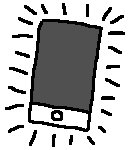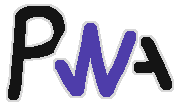The History of the Internet
This text was originally written as an assignment about the history of the Internet for my web development course in Gymnasiet during November of 2022. It has been translated from Swedish to English, but the content is preserved in its original state. The Swedish version can be found here.
The Internet has become an essential part of our lives. Accessible via computers, smartphones, and even various ‘smart’ devices such as TVs, fridges or even a smart toaster. But how did we get to this point? And what led to the information age we live in now?
1960s/1970s: ARPANET as a research project
The Internet began as a research project by the American ARPA to connect and send messages between computers, called ARPANET. On 29 October 1969, the first message was sent between two computers, one at UCLA and one at Stanford.
As ARPANET was developed and many research institutes around the US were connected, the first e-mail was sent in 1971 and by 1973 as many as 40 computers were connected to ARPANET. But it was not until 1973 that ARPANET became an international network, or internet. Signals would be sent from the US to the Norsar research centre in Norway via a ground station in Bohuslän, Sweden.
1974 saw the development of the TCP/IP protocol, a standard for packet-switched networks. This is still what is used on the modern Internet but it was not always so. There was another protocol called X.25, which was a favourite among the telecommunications companies as it was centralised and the companies could charge for the traffic that flowed through.
1980s: Internet becomes civilian
However TCP/IP eventually prevails, as its decentralised protocol was faster and more flexible. January 1983, ARPANET switches to the TCP/IP protocol and the network also becomes "civilian", opening up to anyone who wants to connect to it. The US military creates its own MILNET network as ARPANET was previously mainly for military purposes, and this civilian ARPANET becomes the start of the real Internet as we know it today.
1983 also sees the implementation of DNS, a system for linking IP addresses of computers to human-readable names, making it easier to keep track of all computers. Compared to the previous registry, the domain name system was automated and distributed making it more scalable as the internet grew and even more computers joined the network.
In Sweden, the first connection comes in the summer of 1984 when Ulf Bilting sets up the first Swedish IP network 192.5.50.0/24 that connects to ARPANET. The top-level domain .se is registered in 1986 and in 1988 Swedish universities are connected using SUNET.
1990s: World Wide Web
At this point, the Internet existed, but the web as we know it today had not yet been invented. All the data on servers and other computers on the network was scattered in no order whatsoever in a file server or something similar. It was only with the World Wide Web in 1989 with the first web browser and the HTTP protocol that the web we see today emerged. The WWW was first developed by Tim Berners-Lee at CERN in 1989, and the rights were later released in April 1993. In 1994, Tim Berners-Lee founded the W3C which is an organisation that decides on open web standards.
From this point on, the Internet starts to become more commonplace for ordinary people. In addition to the original browser created by Tim Berners-Lee for NeXTSTEP, NCSA Mosaic is launched in 1993. It supported graphics, images and sound within the browser itself, and was the first browser to have a wide impact with its Windows version.

After some time, Netscape Navigator came along and became the most popular browser. NCSA licences its browser to Microsoft, which becomes the basis for their Internet Explorer, which took a stranglehold on the browser market once it became available for free with Windows. This eventually led to a lawsuit in which the US Department of Justice accused Microsoft of using its dominant position with Windows to increase the use of Internet Explorer.
Meanwhile in the 1990s, the web evolves into what we know today. In 1990, Swipnet becomes Sweden's first commercial Internet service provider. Linköping University's computer association Lysator launches Sweden's first website in 1993, the Swedish IT Commission is set up to disseminate information and promote digital development, and Aftonbladet becomes the first Swedish online newspaper in 1994.
In December 1995, the Altavista search engine is launched, which is a success as it can provide better search results. This was because Altavista's database was automatically indexed by spiders crawling around the web, saving not only the page title but also all the text on the page, and could do a full-text search on page contents.
In 1997 the Swedish Internet Foundation is founded, who takes over responsibility for the .se domain and also aims to work for an internet that contributes positively to society.
As a further development of Altavista, Larry Page and Sergey Brin start a research project in 1996 to organise the web's information. They invented the PageRank algorithm, which ranks websites according to how many inbound links from other websites they have. Compared to Altavista and other earlier search engines that listed results by the number of times a word appears on a page, it made it harder for spam to get high up in search results.

This search engine is of course Google, which was launched in 1998 and already in 2001 Google overtakes Altavista, both because of its better search results without spam and its minimalistic design that was faster and with less distracting advertising.
In 1999, broadband breaks through in Sweden with Bredbandsbolaget which connects 350 000 households to the Internet through an agreement with HSB. Telia also invests in more Swedish connectivity, spending 1.4 billion SEK to connect one million households.
2000s: Mobile revolution

At the turn of the millennium, there was a risk that some old but mission-critical systems that described the year with two digits would break down as the year 1999 turned into the year 2000, the so-called Y2K problem or the "millennium bug". According to the computer the year would then be 1900 and the nightmare scenario was that infrastructure, airplanes, nuclear power stations and everything else with non-updated software would suddenly shut down at midnight.
Billions were spent updating computer systems to use years with four complete digits. No major disasters ended up occurring, but what would have happened if the systems had not been upgraded is unclear.
In 2001, Wikipedia is launched and Swedish becomes one of the first non-English Wikipedia versions. The wiki format allows anyone to contribute and add information to what has become the largest encyclopedia, serious and unserious alike, but vandalism is removed as soon as someone else sees them.
In 2004, The Facebook was launched as a community for Harvard students. Subsequently, students from many other American universities are accepted into it, and next year it is released to everyone with "The" removed and becomes an instant success.
On the first of April 2004 Google started up Gmail. It promised 1GB of storage for each email address which was unheard of for a free email service at the time, and its launch on 1 April led many to believe it was an April Fool's joke. But it was no April Fool's joke and Gmail continues to be one of Google's flagship products to this day, now with 15GB of free space for everyone.
Another development with Gmail was its interface, which used JavaScript and so-called AJAX to create a more interactive interface that was more responsive. JavaScript had been around since 1995 in Netscape, but this was the start of "web apps" that used JavaScript to create interaction on the web in ways that challenged traditional applications.

Videos had long been available online, but it wasn't until around 2005 when YouTube was launched that bandwidth was fast enough to stream video in decent quality. Google bought YouTube the next year and YouTube became a success and synonymous with online video to this day.
2007 saw the launch of the first iPhone. Previously, the Internet had existed on older feature phones, but these were very minimal and used technologies like WAP. With the iPhone and its touchscreen, you could access standard desktop websites and you pinch with two fingers to zoom in or zoom out on them.

When the iPhone was released it did not support Flash, a technology that much of the web used at the time. However, Flash was very resource demanding as well as a proprietary technology developed by Adobe, which led to the iPhone not supporting Flash but instead focusing on open web technologies such as HTML5. This was the beginning of the decline of Flash and the start of the open web technologies, and in 2017 Adobe announced that Flash would be shut down by the end of 2020.
Initially, the iPhone also did not support the apps we know today, as you were intended to use the built-in browser for web apps. However, it turned out that web technologies were not fully developed at that time and the App Store was released with the next iPhone 3G, in 2008.

Google, already on its way to becoming a major part of the Internet after starting out as just a search engine, developed Android which was an open source operating system for smartphones that any manufacturer could use for their phones. In 2008 the first phone with Android (HTC Dream) was launched and many other manufacturers made their own phones running Android.
With smartphones you could be connected anywhere and at any time. Using Wi-Fi and 3G, you could stay connected as long as you were near a wireless router at home or in a café, or had mobile phone coverage. This was really the start of modern social media and 24/7 connectivity, the positive impacts as well as the negative.
2010s: Apps apps apps! …And their consequences

2010 sees the launch of Instagram, a social media app for posting photos. The next year in 2011 saw the launch of Snapchat, a messaging app for sending pictures and messages. These have influenced the way we communicate and share our experiences and are still popular services today.
In the 2010s, more and more people start to come online via their mobile phones. With this, things start to go "viral" in an unprecedented way and campaigns can be organised online, for better or worse. For example the Arab Spring of 2011, which was a series of protests in the Middle East that were started and sustained by spreading the message and organising on various social media.
In Christmas of 2012 in Sweden, an Instagram account was set up with the aim of victimising and smearing girls online. This led to a large riot outside Plusgymnasiet in Gothenburg, the first hate mob in Sweden to be started and organised online.
In 2013, Electron is released alongside the Atom text editor, an embedded version of the Chromium browser that could be used to make traditional desktop applications using web technologies. Now it is used for everything from Visual Studio Code, Discord, Spotify and more to create an experience similar to traditional applications that also works on the web without any changes.

Similarly, the concept of "Progressive Web Apps" (PWAs) was coined which is a technology that allows web apps to be installed via the browser as a regular program or app. This was a further development of the vision of iPhone web apps, at a time when web technologies were more developed and could be seen as an alternative to traditional Android and iOS apps, which could be written once using web technology and work on all platforms.
Around the end of the 2010s, questions start to be asked about all the data that Internet companies collect. Because when Internet services are free then the user is the product, and any data you give to companies they then sell on for purposes such as advertising or manipulation. From Google capturing everything you do on your Android phone to how Facebook allowed companies like Cambridge Analytica to use their user data for election fraud in the form of manipulating public opinion. 2018 saw the introduction of new privacy laws in the EU (GDPR) aimed at strengthening users' rights and privacy to their data.
The negative health consequences caused by social media are also starting to be brought up. Social media is most profitable when it is addictive to the user and creates conflict, which has led to increased radicalisation as the algorithm recommends only content the user is interested in, which can lead to a filter bubble where only their own views are brought up and reinforced. In 2018, Apple and Google respectively launch new updates for their mobile operating systems in response to this to allow users to see and control how they use their mobile.
2020s: COVID-19

At the beginning of 2020, a pandemic spread across the world usually referred to as COVID-19. This led to lockdowns and many people switched to remote work to a much greater extent. Through services such as Google Meet and Zoom, people could participate in their work or education from their own home without being physically there. This had already existed before but the pandemic was a starting point to show that this really worked, and even when some may consider the pandemic to be over many people now continue to work remotely.
In October 2022, Elon Musk finalises his purchase of Twitter and immediately starts firing everyone he deems unnecessary, including the former CEO and other senior people. One of his first changes is that people can now pay for verification status, something that was previously only given to… verified users. The result was lots of fake accounts for real companies and people, including Musk himself.

As a result of this takeover of Twitter and its instability under new leadership, many moved to Mastodon, a decentralised social media service similar to Twitter but not controlled by a single company and where user data is not used for advertising or other profit-driven purposes. It works by organisations and individuals setting up their own instances that can communicate with each other to create a larger federated network. This makes it scalable as there is no company behind it that needs to bring in large amounts of revenue to keep the service running, but each instance brings in small amounts of money to fund themselves through e.g. donations.
The Future…
The Internet of the future may look more decentralised. From centralised services with companies behind them whose profit motive turns the user into a product to be manipulated, to a more decentralised one where individuals and organisations control small clicks of what then communicates with the rest of the network. The move from Twitter to Mastodon may be the start of this, in response to a growing scepticism towards big Internet companies and somehow a desire to go back to a more human web that is not controlled by just 5 big Internet companies whose profit motive is to basically exploit the user.
Donations
Did you find the blog post to be informative, amusing or otherwise interesting? All blog posts are written by a human who would appreciate a donation if you got some value out of this piece of writing.